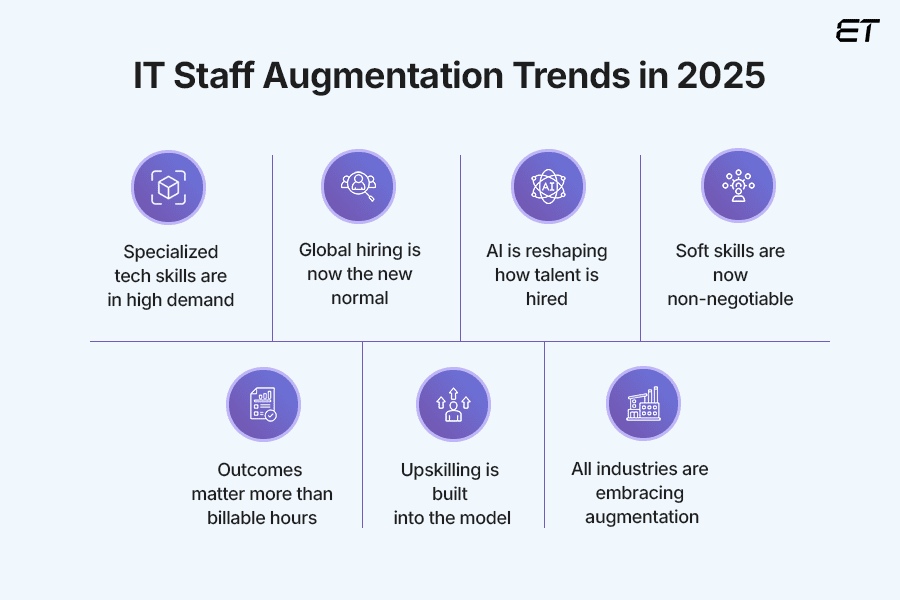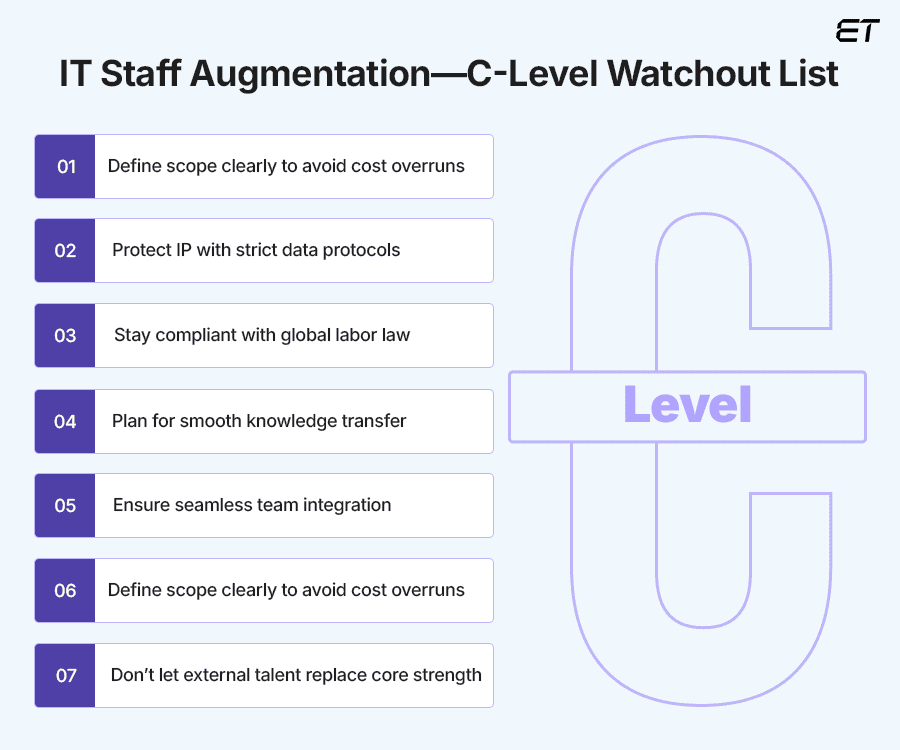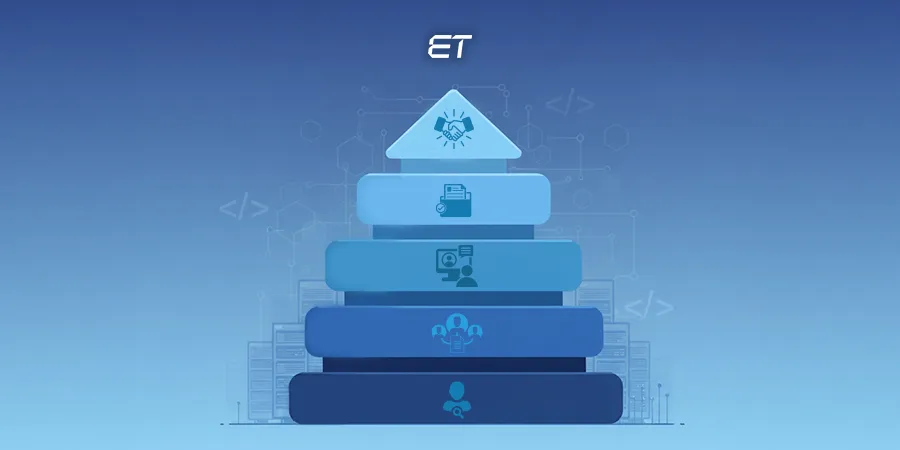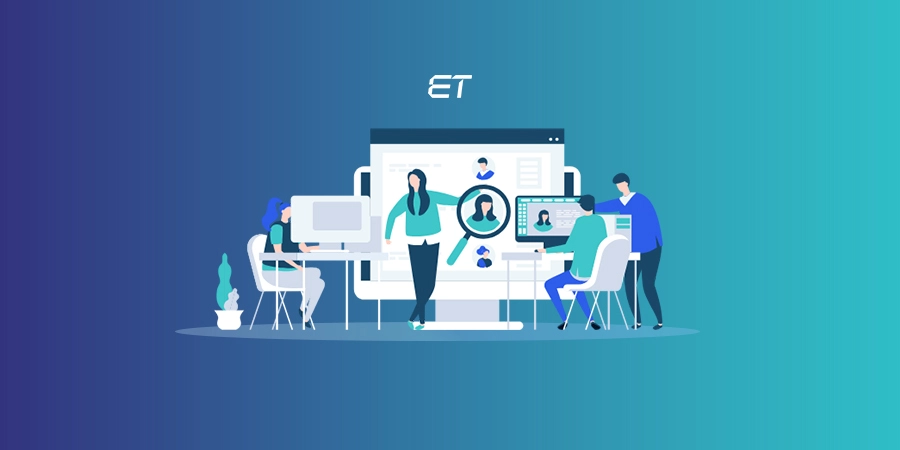
IT Staff Augmentation Trends in 2025- Build Agile Teams
Let’s face it—finding and keeping top tech talent in today’s fast-moving digital world feels like trying to catch lightning in a bottle. Whether you’re rolling out a cloud migration project, scaling your data teams, or accelerating your AI roadmap, the pressure to move faster while staying lean is real.
That’s how IT staff augmentation trends became a core part of how smart companies scale. But in 2025, the game has changed. Staff augmentation is no longer just about plugging resource gaps but building high-impact, flexible teams responding to innovation needs in real time.
In this blog, we’ll walk you through the most critical IT staff augmentation trends shaping 2025. From AI-powered hiring to the rise of specialized talent on demand, we’ll break down what matters most, so you can stay ahead, agile, and competitive.
Need tech talent on demand? Let’s extend your team with the right experts!
IT Staff Augmentation Trends in 2025
As the adoption of IT staff augmentation grows, so does your responsibility of making the right strategic decisions around it. As a C-level executive, you must stay updated on the latest IT staff augmentation trends.

#1 Surge in Demand for Specialized Skills
One of the strongest trends in 2025 is the demand for deep, specialized tech skills. As technologies like AI, machine learning, blockchain, and cloud-native development become essential to digital growth, finding talent with hands-on experience in these areas is getting tougher.
Instead of spending months hiring and training full-time employees, companies are turning to staff augmentation partners to bring in quickly:
- AI and ML Specialists: With the AI market projected to reach $244 billion by 2025, many organizations like yours seek experts to develop and manage intelligent automation and predictive modeling.
- Cloud Computing Professionals: The shift to cloud-based solutions necessitates talent proficient in platforms like AWS, Azure, and Google Cloud.
- Cybersecurity Experts: As cyber threats have become more sophisticated, the demand for skilled security professionals continues to rise. These experts are specialists in managing advanced threat protection.
This just-in-time access to niche talent allows you to innovate faster without the long-term cost or risk of over-hiring.
#2 Borderless Hiring is the New Standard
With time and trends evolving, remote work has become a standard practice. And that’s made global talent sourcing more accessible than ever. In 2025, businesses are tapping into a worldwide pool of skilled professionals through staff augmentation.
Why does this matter?
- Broader Talent Access: You can now source the best talent regardless of geographical boundaries. You’re no longer limited to local hiring markets.
- 24/7 Operations: Distributed teams allow you continuous productivity across different time zones, enabling round-the-clock development.
- Cost Efficiency: Hiring from regions with lower living costs can lead to significant savings. Overall, you get cost efficiency without compromising on skill quality.
That said, international hiring comes with complexities like compliance with labor laws, IP security, and managing cultural differences. That’s why many companies partner with trusted augmentation vendors who handle these aspects end-to-end, strictly and carefully.
#3 AI is Revolutionizing Talent Matching
Hiring the right talent immediately or within a short period is becoming a top priority, and AI is making it easier. Many IT staff augmentation platforms are now using artificial intelligence for hiring. How? Let’s see below:
- Automated Screening: AI tools can quickly sift through resumes to identify suitable candidates for your organization. It automatically matches job requirements with ideal candidates.
- Predictive Analytics: AI helps you analyze past hiring data. This allows you to predict a candidate’s success and fit. You can examine their communication skills and collaboration styles using behavioral data.
- Bias Reduction: AI helps you minimize unconscious bias in the hiring process, promoting diversity.
This trend shortens the hiring cycle and ensures a better fit between talent and project needs. According to Statista, in 2025, 69% of organizations are hiring new employees with AI-related skills, highlighting the growing importance of AI in the workplace.
#4 Soft Skills are Now a Must-Have
Technical skills may get candidates hired, but soft skills determine how well they’ll integrate and contribute to your team.
In 2025, companies are placing greater emphasis on qualities like:
- Communication and collaboration
- Adaptability in fast-changing environments
- Problem-solving and critical thinking
- Emotional intelligence and team alignment
Top IT staff augmentation firms now assess candidates for both hard and soft skills, ensuring that the talent you onboard can work seamlessly with your in-house teams.
#5 Outcome-Based Contracts Are Replacing Hourly Models
Another major shift in IT staff augmentation trends is the rise of performance-based engagement. Rather than paying for time, you pay for the outcomes you receive.
- Aligned Objectives: Both parties focus on achieving defined outcomes, ensuring mutual success for your client and you.
- Cost predictability: Fixed pricing for deliverables helps you budget and plan financially.
- Enhanced Accountability: As the vendors are paid for your project’s outcome, they become more accountable for it as they are paid for their high-quality work efficiently.
For example:
- Deliver a working MVP in six weeks
- Complete a cloud migration by Q3
- Improve application performance by 30%
This model aligns vendor accountability with business goals and gives you more control over budget, timelines, and ROI.
#6 Continuous Learning and Upskilling are Embedded
Outdated skills can slow down your innovation. In 2025, forward-thinking augmentation vendors are offering ongoing training and certifications to their consultants. That means the developers you bring on board are already up to speed with the latest tools, languages, and best practices.
The result?
- Reduced onboarding time
- Lower training costs
- Teams that are equipped to handle emerging tech demands
#7 Industry-Wide Adoption is Fueling Growth
IT Staff augmentation trends are no longer limited to IT services companies. It’s being widely adopted across industries like:
- Finance: You can build secure fintech platforms and fraud detection systems
- Healthcare: You can build data privacy-compliant systems and remote care solutions
- E-commerce: You can build omnichannel platforms, AI-driven product recommendations, and scalability
- Manufacturing: You can build IIoT (Industrial Internet of Things), automation, and smart systems
- Logistics: You can do real-time supply chain monitoring and predictive analytics
Each of these industries benefits from staff augmentation’s flexibility and agility, especially when speed-to-market is critical.
Bridge the talent gap to boost your teamwork. Discover how IT staff augmentation fuels collaboration!
What C-Level Executives Need to Watch Out for in IT Staff Augmentation
Now that you know the IT staff augmentation trends of 2025, let’s see what aspects you should look for in your IT staff augmentation partner as a C-level executive.

1. Vendor Quality and Talent Vetting
Not all augmentation partners follow the same standards regarding sourcing and vetting talent. Some will focus on quantity over quality, delivering fast but not consistently the right fit. Therefore, you must thoroughly check the partner’s background.
What to check?
- Does the vendor conduct technical interviews or just forward resumes?
- Are soft skills and cultural fit part of their screening process?
- Is there a trial or replacement policy if a hire doesn’t perform?
Why does it matter?
Bringing in talent that doesn’t align with your team’s culture or lacks the necessary expertise can delay projects and hurt productivity.
2. Intellectual Property and Data Security
When you bring in external talent, especially offshore, there’s a real risk of data exposure or IP leakage if protocols aren’t watertight.
Ensure that:
- NDAs and data handling agreements are in place.
- Access to sensitive systems is permission-based and time-limited.
- The vendor has robust cybersecurity protocols and incident response plans.
Why does it matter?
Even a single security lapse involving a temporary developer can lead to legal issues, financial losses, and reputational damage.
3. Compliance with Regional Labor Laws
If you’re augmenting teams from different countries or states, it’s critical to understand their local employment, tax, and contract laws.
Therefore, you must consider:
- Does your augmentation partner manage local payrolls, tax obligations, and benefits?
- Are there any hidden liabilities related to classification, i.e., contractor vs. employee?
- Is your company protected against misclassification penalties?
Why does it matter?
Non-compliance with labor laws, even unknowingly, can lead to fines, legal complications, and project disruptions.
4. Lack of Knowledge Transfer and Continuity
One of the overlooked risks in staff augmentation is the loss of knowledge when a contract ends, or talent rolls off a project. This becomes a real challenge when the temporary resource holds key system knowledge.
Its best practices include:
- Building structured knowledge transfer processes.
- Documenting workflows, decisions, and technical configurations.
- Having overlap periods during offboarding for a smooth handover.
Why does it matter?
Without a clear transfer of knowledge, you risk technical debt, operational slowdowns, and even system errors.
5. Managing Integration with In-House Teams
Bringing augmented staff into ongoing projects can lead to confusion, friction, or delays, especially if roles and responsibilities aren’t clearly defined.
To prevent this:
- Set expectations early between internal and augmented teams.
- Use the same communication and project management tools.
- Assign a liaison or integration lead to oversee coordination.
Why does it matter?
Smooth collaboration leads to faster project delivery, higher morale, and fewer internal silos.
6. Cost Overruns from Poor Scope Planning
If you don’t define your projects well, time-and-material billing can spiral out of control. This is especially true in augmentation models that don’t link output to value delivered.
Therefore, you must:
- Clearly define your scope, milestones, and deliverables.
- Where possible, move to outcome-based contracts.
- Regularly track your effort vs. outcomes and revisit your goals.
Why does it matter?
Without financial control and performance metrics, augmentation can shift from being a cost-saver to a cost-burden.
7. Overdependence on External Talent
While staff augmentation offers flexibility, relying too much on outsourced teams can weaken your internal capabilities over time.
Therefore, to mitigate the risk of overdependence, you should:
- Maintain a balance between core in-house teams and augmented roles.
- Use augmentation as an opportunity to train or mentor your internal staff.
- Retain strategic decision-making within your permanent workforce.
Why does it matter?
Sustainable growth comes from external support and internal capability-building, not outsourcing everything.
Augment your team with top tech talent. Scale smarter, faster, and better!
Wrapping Up!
The future of IT talent isn’t fixed; it’s flexible. As 2025 unfolds, the companies winning the tech race won’t be those with the biggest teams but those with the most innovative approaches to building them. IT staff augmentation trends offer the agility to innovate without overextending and the expertise to move faster without compromising quality.
For forward-thinking leaders, the question isn’t whether to embrace staff augmentation but how fast you can make it part of your long-term strategy.
Need a talent that adapts and delivers? Let’s augment your team with experts who fit, fast.
Frequently Asked Questions
1. What is the future of staff augmentation?
The future of staff augmentation is all about agility, specialization, and global accessibility. With rapid tech advancements and talent shortages, companies are moving away from traditional hiring models and embracing flexible workforce strategies. In 2025 and beyond, staff augmentation will continue to evolve.
2. How can staff augmentation help companies scale faster?
Staff augmentation helps you scale quickly by giving you instant access to skilled professionals without the time and cost of full-time hiring. It allows you to expand your teams for specific projects, respond to sudden growth, or meet tight deadlines, without sacrificing quality or continuity. This flexibility makes it easier to align workforce capacity with your business needs.
3. What is the difference between consulting and staff augmentation?
Consulting provides expert advice and strategic guidance, often from outside your organization. Consultants analyze your business challenges and recommend solutions, usually with a hands-off role in execution.
In contrast, staff augmentation adds external professionals to your team who work under your direction. They fill specific skill gaps and integrate with your internal workflows, just like in-house employees, but they are more flexible.
Learn the differences between them in detail Staff augmentation vs Consulting.
4. What is planning for future staffing needs?
Planning for future staffing needs involves forecasting what talent your business will need in the months or years ahead and creating a strategy to meet those needs. It consists of:
- Identifying skills gaps
- Aligning hiring plans with business goals
- Preparing your workforce for upcoming projects or market changes
If done right, it ensures you always have the right people in place to drive growth.





